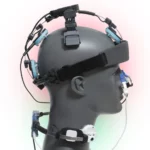For years Alzheimer’s has remained a formidable challenge in neuroscience, characterized by progressive cognitive decline and memory loss. Recent research evidence offers new hope. What is the Alzheimer’s breakthrough?
The answer: a light therapy that has attracted intense interest among researchers over the past five years. Previously known as low level laser therapy, the term used now for this breakthrough therapy is photobiomodulation.
In the video below I provide an overview of the evidence for photobiomodulation as of late 2024. I continue to be excited about using light therapy to improve cognition after reviewing the 2025 research studies that report improvements in memory with photobiomodulation.
This is an option worth taking seriously to improve memory and cognition.
The pioneer in this field is Vielight, a company in Toronto Canada that has engineered photobiomodulation devices which deliver the light therapy with head helmets and nasal applicators illustrated in the image to the right. Visit (https://www.vielight.com) for more information. When ordering any of their devices be sure to claim a 10% discount with coupon code healing4me.
that has engineered photobiomodulation devices which deliver the light therapy with head helmets and nasal applicators illustrated in the image to the right. Visit (https://www.vielight.com) for more information. When ordering any of their devices be sure to claim a 10% discount with coupon code healing4me.
They also extend an invitation to return a device after six month of use to claim an 80% refund if you do not celebrate an improvement in symptoms.
Vielight alone has sponsored 30 independent studies using their devices to evaluate the value of photobiomodulation as a therapy for Alzheimers, Parkinsons and other brain challenges.
I invite you to take a peak at a selection of study abstracts listed published in 2024 and 2025. As you can readily ascertain, researchers across the globe now view photobiomodulation as an Alzheimer’s breakthrough.
Photobiomodulation Studies Published in 2025
J Alzheimers Dis. 2025 Jul 23:13872877251361033. Improved cognitive function, efficiency, saccadic eye movement, and depressive symptoms in mild cognitive impairment with transcranial photobiomodulation
Abstract
Background Mild cognitive impairment is a critical stage with higher progression to Alzheimer’s disease, yet effective interventions are still lacking.
Objective
Some empirical studies have shown that transcranial photobiomodulation may be effective in enhancing cognitive function. To further investigate its effectiveness, a controlled experiment was conducted.
Methods
In this study, 36 community-dwelling older adults with mild cognitive impairment were assigned to receive either real photobiomodulation (experimental group; n = 25) and others without intervention (control group; n = 11) over three weeks.
Results
Compared to the control group, the experimental group demonstrated significant improvements. They showed enhanced cognitive efficiency, as evidenced by improved visual working memory performance, reduced anti-saccade latency, higher scores in the Montreal Cognitive Assessment, and faster completion time in the Shape Trail Test B. In addition, significantly more participants in the experimental group showed improvement in depressive symptoms after the intervention.
Conclusions
These findings provide evidence that photobiomodulation effectively improve neuropsychological, physiological, and psychological outcomes in individuals with mild cognitive impairment.
J Clin Med. 2025 Mar 6;14(5):1766. Efficacy of Transcranial Direct Current Stimulation and Photobiomodulation in Improving Cognitive Abilities for Alzheimer’s Disease: A Systematic Review
Abstract
Background: Due to the increasing global prevalence of Alzheimer’s dementia, neuromodulation techniques such as transcranial direct current stimulation and photobiomodulation are considered potential complementary therapies.
Objective: We assessed the efficacy and safety of both therapies and their potential to enhance cognitive functions in individuals with Alzheimers.
Methods: This review primarily examined studies designed to evaluate the efficacy, followed by an assessment of the safety of the two therapies for people with Alzheimers.. The databases searched resulted in a review of 17 published randomized and controlled trials.
Conclusions: Both transcranial direct current stimulation and photobiomodulation improved cognitive abilities.
J Alzheimers Dis. 2025 Mar;104(1):52-60. Effects of whole-head 810 nm near-infrared therapy on cognitive and neuropsychiatric symptoms in Alzheimer’s disease: A pilot study
Abstract
Background
Alzheimers disease is a progressive neurodegenerative disorder characterized by significant cognitive and behavioral impairments. Photobiomodulation (Near-infrared light) treatment has shown potential in cognitive improvement in previous studies.
Objective
This study investigated the safety and effects of whole-head 810 nm Near Infrared Light therapy in Alzheimers patients, including long-term efficacy.
Methods
Nine Alzheimers patients completed 4-month treatment (810 nm, 100 mW/cm², 30 min/session, 6 sessions weekly). Safety and efficacy were evaluated at baseline, months 2 and 4, and 2-month post-treatment.
Results
After four months of whole-head NIR treatment, mean changes from baseline on the Mini-Mental State Examination were 3.2 (p = 0.02). Mean changes from baseline on the Alzheimer’s Disease Assessment Scale-Cognitive were -5.0 (p = 0.05), mean changes from baseline on the Montreal Cognitive Assessment were 1.9 (p = 0.12). Mean changes from baseline on the Neuropsychiatric Inventory were -4.2 (p = 0.47). These benefits were sustained two months at least. With no device-related adverse effects were reported.
Conclusions
Whole-head near infrared light therapy is safe and offers promising benefits for Alzheimers patients.
Phtobiomodulation Studies Published in 2024
Alzheimers Res Ther. 2024 May 21;16(1):114. Photobiomodulation in experimental models of Alzheimer’s disease: state-of-the-art and translational perspectives
Abstract
Despite decades of research into therapeutic strategies for Alzheimers, effective prevention or treatment for this devastating disorder remains elusive.
In this review, we discuss the potential of photobiomodulation for preventing and alleviating AD-associated pathologies with a focus on the biological mechanisms underlying this therapy.
The available evidence indicates that different treatment paradigms, including transcranial and systemic photobiomodulation, along with the recently proposed remote Photobiomodulation, all could be promising for Alzheimer’s.
Photobiomodulation exerts diverse biological effects, such as enhancing mitochondrial function, mitigating the neuro-inflammation caused by activated glial cells, increasing cerebral perfusion, improving glymphatic drainage, regulating the gut microbiome, boosting myokine production, and modulating the immune system.
Conclusion: We suggest that photobiomodulation serves as a powerful therapeutic intervention for AD.
Future Sci OA. 2024 May 24;10(1):FSO922. Unleashing light’s healing power: an overview of photobiomodulation for Alzheimer’s treatment
Abstract
Aim: Photobiomodulation involves the use of low-level light therapy or near-infrared light therapy found to be useful in the treatment of a wide range of neurological diseases.
Objective: The aim is to review the mechanism and clinical applications of photobiomodulation therapy in managing Alzheimer’s disease.
Methods: To ensure that the consensus statement accurately reflects both the experts’ viewpoint and the most recent developments in the field, the expert opinions were recorded and thoroughly reviewed.
Results: Photobiomodulation elicits reduction of beta-amyloid plaque, restoration of mitochondrial function, anti-inflammatory and antioxidant properties with a stimulation in ATP synthesis.
Conclusion: Photobiomodulation could be helpful in patients non-responsive to traditional pharmacological therapy providing significant aid in the management of Alzheimer’s disease.
Photodiagnosis Photodyn Ther. 2024 Apr:46:103991. Photobiomodulation’s potential as a non-invasive therapy for alzheimer’s disease and minimal cognitive impairment: A 12-week investigation.
Background: To explore the realm of non-pharmacologic therapies, our study evaluates the 12-week impact of non-invasive Photobiomodulation light therapy on cognitive and psychological aspects in individuals with Alzheimer’s and minimal cognitive impairment.
Method: 13 patients (6 case patients and 7 control patients) participated in the study. Sham treatment was administered to seven individuals, while another six received photobiomodulation treatment over 12 weeks, with daily at-home LED (810 nm wavelength) device usage lasting 20 min.
Results: The mean reduction of Hamilton’s anxiety questionnaire score was 3.33±6.08 in the intervention group and 2.00±3.46 in the control group (p-value=0.836). The mean score reduction of the Hamilton depression questionnaire was 3.16±3.86 in the intervention group and 4.85±6.20 in the control group (p-value=0.836). The mean score of the DAD questionnaire in the intervention group before the study was 25.50±13.13 and after the intervention was 29.83±12.12 (p-value=0.084) and in the control group it was 29.71±8.19 and after the study was 29±0.972 (p-value = 0.526). The mean changes in the DAD questionnaire score in the intervention group increased by 4.33±4.92 and decreased by 0.71±2.81 in the control group (p-value=0.041).
Conclusion: Photobiomodulation light therapy holds promise as a potentially safe method for enhancing the cognitive, functional, and psychological status of individuals with Alzheimer’s disease.
Int J Mol Sci. 2024 Jan 28;25(3):1625. Photobiomodulation for Neurodegenerative Diseases: A Scoping Review
Abstract
Based on the characteristics of neurodegenerative diseases such as Alzheimer’s disease and Parkinson’s disease which have prolonged incubation periods and protracted courses, exploring non-invasive physical therapy methods is essential for alleviating such diseases and ensuring that patients have an improved quality of life.
Photobiomodulation uses red and infrared light for therapeutic benefits and functions by stimulating, healing, regenerating, and protecting organizations at risk of injury, degradation, or death. Over the last two decades, photobiomodulation has gained widespread recognition as a non-invasive physical therapy method, showing efficacy in pain relief, anti-inflammatory responses, and tissue regeneration. Its application has expanded into the fields of neurology and psychiatry, where extensive research has been conducted.
This paper presents a review and evaluation of studies investigating photobiomodulation in neurodegenerative diseases, with a specific emphasis on recent applications in Alzheimers and Parkinsons treatment for both animal and human subjects. Molecular mechanisms related to neuron damage and cognitive impairment are scrutinized, offering valuable insights into PBM’s potential as a non-invasive therapeutic strategy.
Robert Rodgers PhD
Founder 2005
https://www.alzheimersrecovery.com
Alzheimers Recovery®

